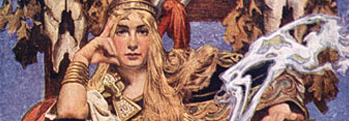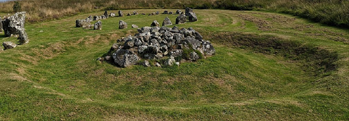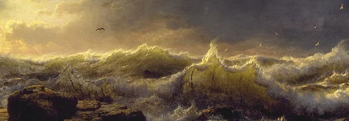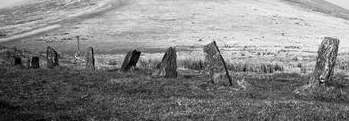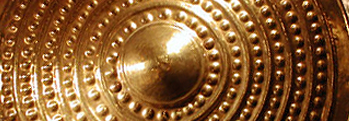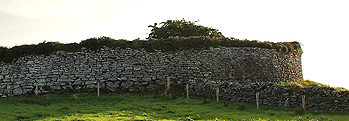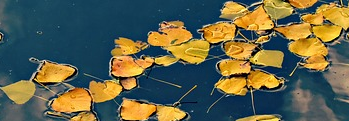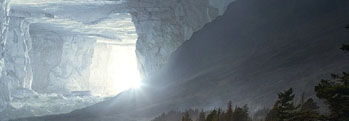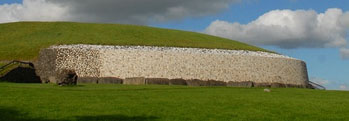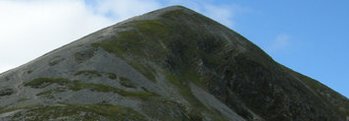The Grianan of Aileach
Irish and Celtic myths and legends, Irish folklore and Irish fairy tales and Legendary Places in Ireland
An ancient royal seat and symbol of power
 The royal ringfort of Grianán Ailigh was known as the father of every building in Ireland by the Annals of the Four Masters, who also claimed it was first built in the year 1500 BC, in the time of the Tuatha Dé Danann! A mighty place of strength it is and was and may always be, one of the few locations in Ireland correctly marked on a map by geographer Ptolemy of Alexandria in the second century anno domine.
The royal ringfort of Grianán Ailigh was known as the father of every building in Ireland by the Annals of the Four Masters, who also claimed it was first built in the year 1500 BC, in the time of the Tuatha Dé Danann! A mighty place of strength it is and was and may always be, one of the few locations in Ireland correctly marked on a map by geographer Ptolemy of Alexandria in the second century anno domine.
Known as one of the Dagda's seats, the Grianán like many ring forts was built near a Sidh or fairy mound, an ancient burial place for some of the first people of Ireland. It also stands over a sacred well, once circled by ten stones. Its name means “the great stone of the sun” and some speculate the old druids used to hold rituals to worship the daystar within its walls.
It has been known by many names over its long history – Aileach, Aileach Neid, Aileach Frigrinn, Aileach Imchell, Grianán Ailigh and Aileach of the Kings.
It stands atop the Greenan mountain at the western tip of the hills that stretch between Lough Swilly and Lough Foyle, commanding views over the counties Derry, Donegal and Tyrone, at the entrance to the Inishowen peninsula. The hill fort was once surrounded by three high and ancient earthen banks upon which warriors raised spear and shield to drive back attackers.
The Grianán's present circular shape may have been devised by the Northern Uí Néill in the sixth or seventh century when the Cenél nEógain won total control of the northlands and made it a symbol of his power. Its walls stand five meters thick and high, with three stepways within, and two long tunnels inside the walls themselves. Various buildings have been raised in the fort down through the centuries, some of wood, and some of stone.
A poem in the Book of Leinster tells that Frigrind was a famous builder who was given the ancient fort of Aileach for his dwelling-place. Here Frigrind built a splendid house of wood for his wife from red yew, carved and emblazoned with gold and bronze, and set it thick with shining gems – perhaps speaking of the glittering mica adorning it today.
And it was written in the Book of Lecan:
“Then were brought the two good men
In art experts,
Garbhan and Imcheall, to Eochaid [Daghda],
The fair-haired, vindictive
he ordered these a rath to build, Aileach.
Around the gentle youth
That it should be a rath of splendid sections -
The finest in Erinn.
Neid, son of Indai, said to them,
[He] of the severe mind,
That the best hosts in the world could not erect
A building like Aileach.
Garbhan the active proceeded to dress
And to cut [the stones]
Imcheall proceeded to set them
All around in the house.
The building of Aileach's fastness came to an end,
Though it was a laborious process
The top of the house of the groaning hostages
One stone closed.”
 It appears from this very ancient poem that not only was the outer rath, or protective circle, of Aileach built of stone by the two masons Imcheall and Garbhan, but the palace and other houses within the enclosure were also built of chipped and cut stone.
It appears from this very ancient poem that not only was the outer rath, or protective circle, of Aileach built of stone by the two masons Imcheall and Garbhan, but the palace and other houses within the enclosure were also built of chipped and cut stone.
It was once the seat of the Kingdom of Ailech, whose reign spanned six centuries, as one of the royal sites of Gaelic Ireland. Here they held their inauguration ceremonies and festivals and counted many famous Kings in their line. It is written in the Life of St. Patrick that Patrick blessed the fortress and left a symbolic flagstone there prophesying that many kings and priests would come from the place.
In 1006, Brian Ború marched through the territory of the Cenel Conail and the Cenel Eogain and probably came to Aileach. In 1101, another king of Munster, Muirchertach Ua Briain, came and ravaged the area, destroying the Grianán of Aileach in revenge for the destruction and demolition of Kincora by Domnall Ua Lochlainn in 1088, after which it fell into disuse for a long time.
Reconstruction work on Grianán Ailigh took place in 1870 under the auspices of Dr Walter Bernard who did a clever job of rebuilding the fortress. He also uncovered many artefacts such as a large stone 40 centimetres across with a piece of wood in a hole in the middle and many animal bones including sheep, cattle, goats and birds.
He also found items including “sling-stones”, “warriors' clubs” and a “sugar-loaf-shaped stone with a well-cut base” as well as a stone fidcheall or Gaelic chess board, described as “a slab of sandstone, chequered into thirty-six squares”.
Grianán Ailigh can be found on the map below!
Legendary Places in Ireland
The extraordinary Ballintubber Abbey, known as Tobar Padraic in the Annals of the Four Mastersm is almost a thousand years old, having been built by King Cathal Crobdearg Ua Conchobair - whose father commissioned the beautiful Cross of Cong - in 1216. It has survived ages and centuries of persecution and fire, providing a place for people to visit ... [more]
One of the rarest and most beautiful woods in the world is Irish bog oak. This very ancient kind of wood can be found across Ireland, but is most often recovered from deep peat bogs in the midlands, and can be anywhere from three thousand to eight thousand years old or more. These trees grew, lived and fell in times of legend, witnessing the rise o ... [more]
One of the most imposing legacies of the last of the mighty megalith-builders of the Neolithic and Bronze ages, the Dolmen of the Four Maols, considered by some to be a cist tomb rather than a dolmen or portal tomb. An enormous capstone sits above three other stones, while the entry stone lies not far off. It was once covered by a cairn of smaller ... [more]
Alone in County Louth rises a tall standing stone, its only company the ravens overhead and the whispering wind given voice by nearby trees. This is Clochafarmore, which means "the stone of the great man". It was first raised during the bronze age and rises to ove three meters in height, in a place whose name means The Field of Slaughter, ... [more]
The Boheh stone in the deepest west of Ireland is one of the finest examples of Neolithic rock art in Europe, over two hundred and fifty petroglyphs wrought by unknown hands on a natural outcrop of rock flecked with quartz stones, on the west side of a hill, facing the setting sun, around 3800 BC. Twice a year at sowing and harvest times this produ ... [more]
Cashel of the Kings, the mighty Rock of Cashel was in olden times known as the Royal Site of the Kings of Mumu, a place we today call Munster. It is a great uplifting of raw limestone from the surrounding grassy plains, which old tales tell was hurled from a mountain called the Devil's Bit, in County Tipperary. It is said to have been where ... [more]
The great northern fastness of Emain Macha means "Macha's twins" or "Macha's pair", and its tale is bound tightly with the local goddess Macha, after whom is also named Armagh, Ard Macha. The ancient Greek philosopher Ptolemy drew a map of the world, upon which he marked a place called Isamnion in southern Ulster, which ... [more]
The spiritual and geographical heart of Ireland is the Hill of Uisneach overlooking a wide plain in view of twenty counties, where the borders of all five kingdoms met, where great decisions were made and assemblies were held, the mórdáil Uisnig, and home to Ail na Mireann, or the Stone of Divisions. On the hill all around this strang ... [more]
The seat of the High Kings of Ireland stretching back to the Tuatha and the Fir Bolg, Tara or Temair as it was known then, is said to have been the seat of a hundred and forty two kings, kingships won by battle, contest and merit, not passed down father to son as in more primitive cultures. It is also known as Teamhair na Rí, 'Tar ... [more]
Dún Ailinne is one of the great Royal Sites of Ireland, "a place of assemblies, a Rath with royal roads, a Grianan or palace, and a Royal Dún", where great ceremonies, rituals and gatherings took place, seat and crowning-place of the Gaelic Kings of Leinster. All that remains of it now is a large circular embankment a ... [more]
The glorious stronghold of Rathcrogan, or Ráth Cruachan, was the Royal Site of the great Kings and Queens of the Western lands for thousands of years. Within its sacred embrace were held the thronging ceremonial assemblies or óenach, and people of every station would gather from all corners of Ireland to reach out and touch, if on ... [more]
The gift of the gab, as it’s known, is a common thing among the Irish – being able to talk all day about anything and everything, and do it in a way that would have you listen as well. It’s as Irish as red hair and freckles. But what if you didn’t have the gift of the gab, or felt a deficiency of gabbiness? Never fear, al ... [more]
The Spring equinox was a very important time for the people of ancient Ireland, heralding as it did the end of the dark season with all of its dangers and want, and signalling the dawn of a new year of plenty. The day and night, the light and the dark side of the year were in equal balance, neither stronger than the other, and it is easy to ... [more]
Ireland is a land of many treasures – some are well known while others are known only to a few, like the mysterious stone circles of Beaghmore! In the north of County Tyrone they can be found, at the edge of the Sperrin mountains looking out over the wide countryside below, dating back to the bronze age and earlier, to the time when the Tuath ... [more]
The royal ringfort of Grianán Ailigh was known as the father of every building in Ireland by the Annals of the Four Masters, who also claimed it was first built in the year 1500 BC, in the time of the Tuatha Dé Danann! A mighty place of strength it is and was and may always be, one of the few locations in Ireland correctly marked on a ... [more]
Knockma of the mists is a place wreathed in secrets and myth where they say sleeps the greatest king of the Sidhe, he whose name was Finnbheara! Should you go for a walk around Knockma Hill, pay close attention to that which you cannot see – a warm breeze meant a good fairy was passing by, and a sudden shiver meant an evil one was close! J ... [more]
Nine is a mystical number in Irish folklore, being thrice three, itself known from ancient times as a mysterious symbol, and so should you happen across nine stones, you would do well to be extra careful! For who knows what might lie sleeping just below the surface. And such a place can be found on the saddle between Sliabh Bán, the White ... [more]
Once upon a time there were many kingdoms in Ireland, and many kings, or perhaps they would have been better known as chieftains, but kings they were for all that. As time went by each of these kingdoms fell and were joined one into the other, but yet a single kingdom still remains in the farthest north and farthest west of the country, and this is ... [more]
Ireland's bones are made of stories, you can hardly step over a rock or walk past an old mound but if it could speak, it would tell you tales you could hardly imagine. But of all the legended glens and fields misty with memory in this ancient nation, there are few with as many secrets hidden in their depths as Lough Gur in county Limerick. S ... [more]
There are tens of thousands of round stone forts in Ireland, some say as many as fifty thousand, if you can believe it, and one of the finest examples we have is at Kilcashel in County Mayo, which comes from the Irish Coill an Chaisil, the woods of the stone fort. Almost perfectly circular in construction, with thick walls two broad men could walk ... [more]
Scattered throughout the Irish countryside are hundreds if not thousands of holy wells, almost all of great antiquity, even predating Christianity. They can take almost any form and show up in any place, shimmering in the shadow of engraved stone monuments, in lapping sea caves where the fresh and salt waters mingle twice a day, as natural springs ... [more]
In county Roscommon there's a place of great antiquity called Oweynagat, which some have mistakenly thought to mean the Cave of Cats, although it has nothing to do with cats - “cath” being the Irish word for “battle” and so it should rightfully be called the battle cave. Indeed it has a long association with the Morrigan ... [more]
The Burren is one of the wonders of Ireland. A rolling rocky landscape of limestone hills and plains, it is marked with history stretching back thousands of years. Nestled in between the limestone slabs are herbs and plants you'd be hard pressed to find elsewhere, hailing from places as far afield as the Arctic and the Mediterranean, kept warm ... [more]
Older than Stonehenge and the great pyramids of Giza stands Newgrange, the heart of legends and mysteries stretching back five thousand years. Situated along the river Boyne near to numerous other such places like Knowth and Dowth, that very same river where Fionn Mac Cumhaill was said to have first found and tasted the salmon of knowledge, and the ... [more]
Dún Aonghasa means "the Fort of Aonghasa", and remains one of the most impressive ancient monuments in Ireland, Europe or the world. Perched on the edge of a high and jagged cliff with the grey-green waters of the Atlantic battering below, it gained its name from its original builders, who were called the Fir Bolg, some of the ... [more]
Croagh Patrick or Patrick's Stack is an important place of pilgrimage for Christians throughout Ireland and the world today, some even walking the ascent in their bare feet as penance for their sins. However it was considered a holy place long before St Patrick came to visit, even though it is said he banished the snakes from Ireland while stan ... [more]
Rising from the ocean a short distance off the coast of county Kerry in southern Ireland, Skellig Michael and its smaller brother rear up out of the Atlantic ocean like jagged grey teeth. Famous poet George Bernard Shaw who visited the place in 1910, called it an "incredible, impossible, mad place" and "part of our dream world". ... [more]














